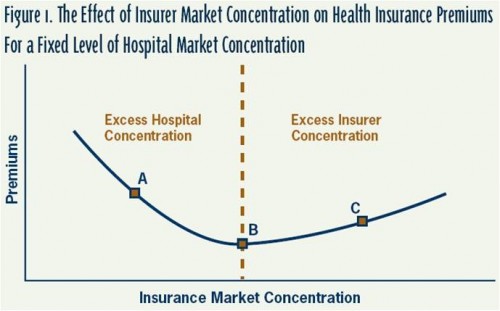Last Friday, the House Ways and Means Subcommittee on Health focused on the implications of hospital mergers and acquisitions. A helpful summary of the meeting can be found at The Advisory Board Daily Briefing. Very briefly, increased hospital market concentration pushes up prices, something we don’t need more of in health care. That market concentration leads to higher prices is a general principal of economics. So, we tend to hear “market concentration” as “something we ought not have more of.” However, when it comes to health care, not all market concentration is bad. Sometimes, more is better.
Take the health insurance market,* for example. It’s famously concentrated. The way the story is typically told is that a few big insurers with massive market clout are demanding excessive premium increases. Wouldn’t we all be better off if the insurance market were less concentrated? Wouldn’t greater competition lead to lower prices?
Not necessarily. One reason it would not is offered by the work of Glenn Melnick, Yu-Chu Shen, and Vivian Wu in their recent Health Affairs paper “The Increased Concentration Of Health Plan Markets Can Benefit Consumers Through Lower Hospital Prices.” Here’s what the authors found:
- “[Sixty-four] percent of hospitals operate in markets where health plans are not very concentrated, and only 7 percent are in markets that are dominated by a few health plans.” Translation: Be skeptical of statements by the hospital industry that most hospitals are suffering at the hands of dominant insurers.
- [I]n most markets, hospital market concentration exceeds health plan concentration.” Translation: In fact, due to their relative market clout, most hospitals have the upper hand in negotiation over price.
- “[G]reater hospital market concentration leads to higher hospital prices.” Translation: Do I really need to translate this?
- “[H]ospital prices in the most concentrated health plan markets are approximately 12 percent lower than in more competitive health plan markets.” Translation: Insurer market power can be a good thing, leading to lower hospital prices.
Consistent with a large body of prior work, some of which they cite (see also this (pdf) and a related FAQ entry), their results
show that more concentrated health plan markets can counteract the price-increasing effects of concentrated hospital markets, and that—contrary to conventional wisdom—increased health plan concentration benefits consumers through lower hospital prices as long as health plan markets remain competitive.
That last bit–“as long as health plan markets remain competitive”–needs some explanation. A question not addressed in the paper is whether insurers that are able to negotiate lower prices due to their relatively higher market concentration pass any of the savings along to consumers in the form of lower premiums. That is, do consumers really benefit if insurers get good prices? Or do insurers just turn around and stick it to the consumer anyway, raking in higher profit? A monopoly insurer would. Insurers in a relatively competitive market would not, or not as much.
This all implies there is a sweet spot, a degree of market concentration of insurers relative to hospitals that leads to the lowest premiums. That’s what my figure illustrates:
However, health economists do not know where that sweet spot is. Sarah Kliff also raised this point–that it is not clear from the paper by Melnick and colleagues precisely how much hospital and insurer market concentration affect premiums. A reason neither this, nor any other study I’m aware of, simultaneously relates insurers’ and hospitals’ market power to premiums is that there are some very challenging econometric issues in doing so and because comprehensive, historical data on commercial market health insurance premiums (as well as benefits needed to standardize them) are not readily available to researchers at relatively low prices. In fact, even the theory has not been fully worked out beyond its qualitative contours.
One final point about lowering private prices to hospitals: it’s not only potentially good for consumers, it’s good for taxpayers. One of the constraints on Medicare’s ability to lower prices it pays to providers is the price level of the private market. Medicare can only push its payments so far below private payers before providers threaten to see fewer Medicare patients, creating a political problem for policymakers.
So, paradoxically, policies that would increase competition among health insurers too much could actually harm consumers and taxpayers. Policies that would increase competition among hospitals, on the other hand, would probably do some good.
(A key caveat to the paper by Melnick and colleagues is that their findings are descriptive and associative. This is acknowledged by the authors and is due to the methods employed. Having said that, the direction of causality between market power and price is accepted by economists based on theory and other empirical work.)
* There is not one health insurance market, but many. For simplicity, unless stated otherwise, I will write as if there were just one.



